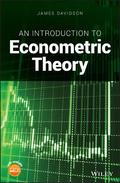An Introduction to Econometric Theory

1. Auflage Oktober 2018
250 Seiten, Hardcover
Wiley & Sons Ltd
A guide to economics, statistics and finance that explores the mathematical foundations underling econometric methods
An Introduction to Econometric Theory offers a text to help in the mastery of the mathematics that underlie econometric methods and includes a detailed study of matrix algebra and distribution theory. Designed to be an accessible resource, the text explains in clear language why things are being done, and how previous material informs a current argument. The style is deliberately informal with numbered theorems and lemmas avoided. However, very few technical results are quoted without some form of explanation, demonstration or proof.
The author -- a noted expert in the field -- covers a wealth of topics including: simple regression, basic matrix algebra, the general linear model, distribution theory, the normal distribution, properties of least squares, unbiasedness and efficiency, eigenvalues, statistical inference in regression, t and F tests, the partitioned regression, specification analysis, random regressor theory, introduction to asymptotics and maximum likelihood. Each of the chapters is supplied with a collection of exercises, some of which are straightforward and others more challenging. This important text:
* Presents a guide for teaching econometric methods to undergraduate and graduate students of economics, statistics or finance
* Offers proven classroom-tested material
* Contains sets of exercises that accompany each chapter
* Includes a companion website that hosts additional materials, solution manual and lecture slides
Written for undergraduates and graduate students of economics, statistics or finance, An Introduction to Econometric Theory is an essential beginner's guide to the underpinnings of econometrics.
Preface xi
About the CompanionWebsite xv
Part I Fitting 1
1 Elementary Data Analysis 3
1.1 Variables and Observations 3
1.2 Summary Statistics 4
1.3 Correlation 6
1.4 Regression 10
1.5 Computing the Regression Line 12
1.6 Multiple Regression 16
1.7 Exercises 18
2 Matrix Representation 21
2.1 Systems of Equations 21
2.2 Matrix Algebra Basics 23
2.3 Rules of Matrix Algebra 26
2.4 Partitioned Matrices 27
2.5 Exercises 28
3 Solving the Matrix Equation 31
3.1 Matrix Inversion 31
3.2 Determinant and Adjoint 34
3.3 Transposes and Products 37
3.4 Cramer's Rule 38
3.5 Partitioning and Inversion 39
3.6 A Note on Computation 41
3.7 Exercises 43
4 The Least Squares Solution 47
4.1 Linear Dependence and Rank 47
4.2 The General Linear Regression 50
4.3 Definite Matrices 52
4.4 Matrix Calculus 56
4.5 Goodness of Fit 57
4.6 Exercises 59
Part II Modelling 63
5 Probability Distributions 65
5.1 A Random Experiment 65
5.2 Properties of the Normal Distribution 68
5.3 Expected Values 72
5.4 Discrete Random Variables 75
5.5 Exercises 80
6 More on Distributions 83
6.1 Random Vectors 83
6.2 The Multivariate Normal Distribution 84
6.3 Other Continuous Distributions 87
6.4 Moments 90
6.5 Conditional Distributions 92
6.6 Exercises 94
7 The Classical RegressionModel 97
7.1 The Classical Assumptions 97
7.2 The Model 99
7.3 Properties of Least Squares 101
7.4 The Projection Matrices 103
7.5 The Trace 104
7.6 Exercises 106
8 The Gauss-Markov Theorem 109
8.1 A Simple Example 109
8.2 Efficiency in the General Model 111
8.3 Failure of the Assumptions 113
8.4 Generalized Least Squares 114
8.5 Weighted Least Squares 116
8.6 Exercises 118
Part III Testing 121
9 Eigenvalues and Eigenvectors 123
9.1 The Characteristic Equation 123
9.2 Complex Roots 124
9.3 Eigenvectors 126
9.4 Diagonalization 128
9.5 Other Properties 130
9.6 An Interesting Result 131
9.7 Exercises 133
10 The Gaussian RegressionModel 135
10.1 Testing Hypotheses 135
10.2 Idempotent Quadratic Forms 137
10.3 Confidence Regions 140
10.4 t Statistics 141
10.5 Tests of Linear Restrictions 144
10.6 Constrained Least Squares 146
10.7 Exercises 149
11 Partitioning and Specification 153
11.1 The Partitioned Regression 153
11.2 Frisch-Waugh-Lovell Theorem 155
11.3 Misspecification Analysis 156
11.4 Specification Testing 159
11.5 Stability Analysis 160
11.6 Prediction Tests 162
11.7 Exercises 163
Part IV Extensions 167
12 Random Regressors 169
12.1 Conditional Probability 169
12.2 Conditional Expectations 170
12.3 StatisticalModels Contrasted 174
12.4 The Statistical Assumptions 176
12.5 Properties of OLS 178
12.6 The Gaussian Model 182
12.7 Exercises 183
13 Introduction to Asymptotics 187
13.1 The Lawof Large Numbers 187
13.2 Consistent Estimation 192
13.3 The Central LimitTheorem 195
13.4 Asymptotic Normality 198
13.5 Multiple Regression 201
13.6 Exercises 203
14 Asymptotic Estimation Theory 207
14.1 Large Sample Efficiency 207
14.2 Instrumental Variables 208
14.3 Maximum Likelihood 210
14.4 Gaussian ML 213
14.5 Properties of ML Estimators 214
14.6 Likelihood Inference 216
14.7 Exercises 218
Part V Appendices 221
A The Binomial Coefficients 223
B The Exponential Function 225
C Essential Calculus 227
D The Generalized Inverse 229
Recommended Reading 233
Index 235


